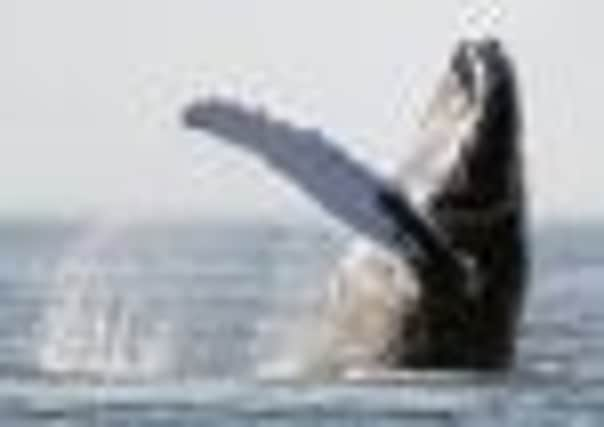The shape of fins to come? Whale watching, not killing, the way forward


THE mass stranding of 26 pilot whales at the foot of the steep coastal path near Pitenweem prompted huge interest from readers of the Evening News and my constituents.
A major rescue was launched with around 50 people from the coastguards, fire services, police and the Scottish SSPCA.
Advertisement
Hide AdAdvertisement
Hide AdUnfortunately by the time the British Divers Marine Life Rescue (BDMLR) arrived, 16 of the whales were already dead. The long-finned pilot whales have strong family bonds, meaning that the species is prone to mass strandings because the whole pod may follow one animal that is ill or confused into shallow water.
At the time of this tragedy, I had been invited by the International Fund for Animal Welfare (IFAW) to observe their campaign in Iceland to end commercial whaling, aboard its 21-metre research vessel Song of the Whale. Off the shores of Iceland, I was able to observe the impact of whale watching on whales.
IFAW has a simple argument, that whale watching has been proven to be far more economically sustainable than whaling. They are working with local MPs, whale watching companies and the Reykjavik Tourist Board to create a whale sanctuary in Faxafloi, the large bay surrounding the capital where whale watching – but also commercial whale killing – takes place. This sanctuary would not stop whaling vessels from going further out to sea but the extra cost of fuel should suggest whales are protected in practice.
On arriving in Iceland I met with Mrs Rannveig Guðmundsdóttir, who chairs the IceWhale network representing six whale-watching companies. She explained to me that economical context of whaling versus whale watching activities.
Advertisement
Hide AdAdvertisement
Hide AdShe stated that, since commercial minke whaling was resumed in 2006, no minke whale meat has been exported to Japan. Neither do any of the minke whaling operations sustain any jobs outside Reykjavik, which used to be a key argument for sustaining the industry. On the contrary, the whale watching industry provides about 150 jobs. The increase in tourism of almost 40 per cent over the past three years will sustain or even increase the number of jobs associated with whale tourism. However, this will only be the case if whaling activities do not interfere with whale watching. It’s as simple as this: whaling and whale watching do not go together.
I also met with Mr Witting, the UK Ambassador to Iceland. Mr Witting expressed his support for the good work that IFAW has done over the years in Iceland with the Meet Us Doesn’t Eat Us campaign. Volunteers hand out leaflets to tourists to raise awareness. The leaflets state that when tourists visit restaurants in Iceland, they should not order whale meat under the false belief that this is a traditional staple dish. He added that he has seen a change in attitude from the younger generation of Icelanders, and explained how the country has changed after the 2008 economic crisis and made an incredible recovery in a very short time. He said tourism is an important part of the economy and that it is crucial that Iceland looks at long-term sustainable options like whale watching.
One of the researchers on board of the IFAW vessel explained to us that whales face more threats than ever by ship strikes, entanglement in fishing gear, man-made ocean noise and climate change.
Fortunately the SOTW is one of the quietest research vessels in the world, and the IFAW research team is undertaking work which involves studying minke whale behaviour in the presence of whale watching vessels compared to their behaviour in an area without whale watching.
Advertisement
Hide AdAdvertisement
Hide AdWhale watching obviously has brought many benefits to Iceland, however, it is important that the potential effects on whales are monitored and minimised to protect their welfare and to secure the sustainability of this business in the long-term. So what can we do to protect these fabulous creatures? Unfortunately 40 per cent of all whale meat consumed in Iceland is eaten by tourists. The first seven items of an eight item menu in a tourist restaurant I visited consisted in some form of whale meat. Tourists mistakenly believe that all Icelanders eat whale and so wrongly consider their impact to be negligible.
IFAW volunteers ask tourists in the airport and other popular destinations to pledge not to eat whale meat. I made that pledge and would encourage any Evening News readers who travel to Iceland to do the same.
It would be a tragedy if any of those wonderful creatures we did save in the Firth of Forth ended up on a dinner plate.
Best places for sightings
WHILE whales have been spotted in the Firth of Forth, sightings are rare.
Advertisement
Hide AdAdvertisement
Hide AdThe minke whale is most common in the waters around Scotland, and the type most likely to be seen, with workers on the Forth bridges having reported viewings.
They feed mainly in shallower water, rather than out in the open ocean, and will often come close to land, even entering estuaries, bays and inlets.
Minke are most often spotted around Scotland between July and September, but they can be seen any time between May and October.
The best areas for whale watching are in north-western Scotland, particularly around the islands of Mull, Coll, Muck, Eigg, Rum and the Treshnish Isles.
• David Martin is a Labour MEP for Scotland